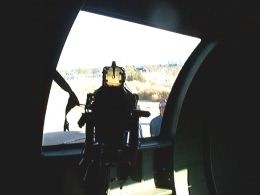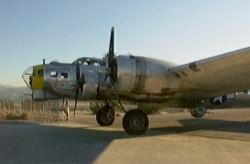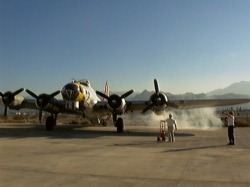|
Fortress in the Sky
by Jim "Twitch" Tittle |
||||
|
From a humble 1934 beginning with the name of Project "A", to Queen of the Sky, the B-17 cut a legendary profile in every theater of operation it entered during World War II. The production for all B-17s was 12,677 planes, two thirds that of the B-24 Liberator. The Lib could tote a heavier bombload and was a bit faster. So what was so endearing about the B-17? She brought her crews home. It didn't matter if the vertical or horizontal stabilizer was gone or if two engines were dead. It didn't matter if the nose was a mangled mass of twisted metal. It didn't matter if huge holes were ripped in the wings or fuselage. The Queen brought the survivors home. Her uniquely rugged construction was the key. With a much thicker chord and a wing area 40% larger than the B-24, plus larger surface areas of all tail sections, she had greater lift and stability in all situations. A class mate of my mother was a B-24 waist gunner over Europe. "When you'd lose one engine everybody started sweating and hoping another didn't go, 'cause the B-24 really didn't fly on two." The Fortresses routinely returned on two fans. This not to say that no Liberator ever did, but it was less often. THE NEED FOR FIREPOWER After its baptism by fire in the Pacific, the "D" model showed its flaw- a blind spot in the tail. Pilots would kick rudder in an "S" turn to allow waist gunners to take turns firing at enemy fighters on their tails. The "E" model solved this problem with a tail gunner and a redesigned, larger vertical stabilizer. It began the "gunning up" which culminated in the "G" model's thirteen .50 caliber machine guns.
 Even without the tail gunner Saburo Sakai found early on that the best way to down a B-17 was with a frontal attack. When the Eighth A.F. began daylight raids in Europe the Luftwaffe soon discovered the same tactic. The "E" began replacing the feeble .30s from the nose station with .50s. And the new ball turret in the belly with two more fifties was a job for smaller guys. Ten crew members now went aloft with a nine or ten MG defensive armament. It weighed 54,000 lbs. The four Wright Cyclone 1,200 HP engines could pull the "E" to 317 MPH maximum. By 1942 the "E" model was operational in every theater of the world. Forty five B17's supplied to RAF Costal Command had the 40mm Vickers "S" cannon mounted in the nose for anti-sub work with 59 Squadron at Thorney Island. One B-17E had Allison V-12 liquid cooled engines experimentally installed which boosted top speed to 327 MPH. HOW MUCH? Mid-1942 saw the "F" model on production lines at Boeing, Douglas and Vega. It had minor improvements to the "E". Later batches had the extra fuel cells in the wings known as "Tokyo Tanks," and more powerful Cyclone GR-1820-97 engines with war emergency rating of 1,380 HP @ 25,000 ft. |
 Generally a .30 caliber was installed in the nose but the .50 was too, depending on the manufacturer. 500 rounds of .30 or 300 rounds of .50 were carried. The waist gunners had 300 rounds and the dorsal turret had 400 r.p.g.for the two .50s. 500 r.p.g. were available for two more .50s in the ball turret, and two .50s in the tail had 565.r.p.g. While a maximum bomb load was 9,600 lb., a typical mission over the Reich carried 4,000-5,000 lb. to make a range of 1,400 miles. The maximum feasible combat radius was about 800 miles. While it is universally known that B-17s "only" carried 4-5,000 lb. on a long range mission, a small number of the "F"" series with the more powerful engines and external wing racks could carry a maximum of 20,800 lb. for a short range!
 "G" WHIZZ The ultimate model of the Fortress was born in production in the summer of 1943. To defend against head-on attacks a power operated chin turret with two fifties sprouted from the sheet metal. With the cheek guns sharing 610 rounds and the chin turret holding 365 rounds, the "G" was the most heavily armed bomber aircraft in the sky with thirteen .50s. The waist gunners now had 600 rounds each to deter Luftwaffe attacks and the "Cheyenne" tail guns offered an increased field of fire. The "G" model had a wingspan of 103 ft. 9 1/2 in.; length 74 ft. 4in. Height was 19 ft. and the wing area was 1,420 sq.ft. It weighed in at 72,000 lb. maximum overloaded from a mere 32,370 lb. empty. The four Cyclone GR-1820-97 engines with war emergency rating of 1,380 HP @ 26,700 ft. had General electric B-22 exhaust driven turbo-superchargers. The "G" could reach a ceiling of 35,000 ft. Top speed was 300 MPH @ 30,000 ft. but maximum continious speed was 263 MPH @ 25,000 ft. Climb rate was 900 ft./min. Carrying 2,810 U.S. gallons of fuel the "G" could haul 4,000 lb. of bombs 1,850 miles in 8.7 hours at 25,000 feet. DORNIER Do 200 It is a little known fact that the Luftwaffe used captured Fortresses. One unit, I/K.G.200, ferried, parachuted, and supplied secret agents. The captured planes bore German insignia. In 1944 one group was involved in constructing and maintaining secret fuel dumps in the Western Desert. To simplify things and guard the secret, the B-17s were designated as "Dornier Do 200s." Join a discussion forum on this article by clicking HERE.
|
|||
|
Copyright © 1997 - 2000 COMBATSIM.COM, INC. All Rights Reserved. Last Updated August 9th, 1999 |
||||
